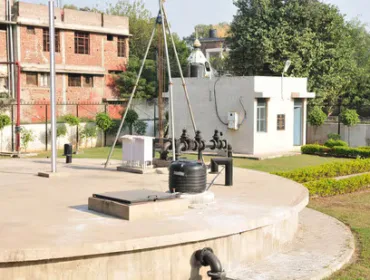Dr. Sabarna Roy, Head [Research & Development], Kejriwal Castings Limited
India, with its vast population and rapidly growing economy, faces significant challenges in managing its water resources. As the demand for fresh water continues to rise, traditional sources such as rivers, lakes, and groundwater are becoming increasingly strained. In this context, desalination technology, which converts seawater into potable water, is emerging as a crucial solution to India’s water woes. This article delves into the significance of desalination technology gaining popularity in India, exploring its potential impacts, challenges, and future prospects.
Addressing Water Scarcity
India is home to more than 1.4 billion people, and with the urban population expected to double by 2050, the demand for fresh water is set to skyrocket. Many regions, particularly in the south and west, face severe water scarcity due to irregular monsoons, over-exploitation of groundwater, and pollution of water bodies. Desalination offers a viable solution by tapping into the abundant seawater resources surrounding the Indian peninsula. By converting seawater into fresh water, desalination can significantly alleviate water scarcity in coastal areas and reduce dependence on over-exploited freshwater sources.
Technological Advancements and Economic Viability
The initial high costs and energy consumption of desalination have been significant barriers to its widespread adoption. However, recent technological advancements have made desalination more energy-efficient and cost-effective. Innovations such as reverse osmosis, low-temperature distillation, and energy recovery systems have reduced energy requirements and operational costs. As a result, desalination is becoming an increasingly viable option for India, offering a sustainable source of fresh water for drinking, irrigation, and industrial uses.
Environmental Considerations
While desalination has many benefits, it also poses environmental challenges, particularly in terms of energy consumption and brine disposal. The process is energy-intensive, contributing to greenhouse gas emissions unless powered by renewable energy sources. Additionally, the disposal of concentrated brine, a byproduct of desalination, can have adverse effects on marine ecosystems if not managed properly. Addressing these environmental concerns is crucial for the sustainable implementation of desalination technology in India.
Regional Development and Social Impacts
The adoption of desalination technology can have profound social and economic impacts, particularly in water-scarce regions. Access to reliable sources of fresh water can improve public health, boost agricultural productivity, and foster economic development. Desalination plants can also create employment opportunities and drive technological innovation. Moreover, by reducing the strain on freshwater resources, desalination can help mitigate conflicts over water rights and usage.
Policy Framework and Public Awareness
The successful integration of desalination technology into India’s water management strategy requires a comprehensive policy framework. This includes regulations on technology standards, environmental impacts, and water tariffs. Public-private partnerships can play a crucial role in financing and operating desalination plants. Additionally, raising public awareness about water conservation and the benefits of desalination is essential for garnering support and ensuring the sustainable use of this technology.
Insights from Case Studies
The Chennai Experience: A Pioneer in Desalination
Chennai, the capital city of Tamil Nadu, is one of the Indian cities that has turned to desalination in response to chronic water shortages. The city operates two major desalination plants: the Minjur Desalination Plant and the Nemmeli Desalination Plant. Together, these facilities contribute around 200 million litres per day (MLD) to the city’s water supply, providing a critical buffer against the irregular monsoons and dwindling groundwater levels that have plagued the region.
The success of these plants has not only alleviated water scarcity for millions of residents but also demonstrated the viability of large-scale desalination projects in India. However, challenges such as high operating costs and environmental concerns related to brine disposal remain. Despite these issues, Chennai’s experience has set a precedent for other Indian cities facing similar water scarcity challenges.
The Gujarat Model: Integration with Solar Power
The state of Gujarat has also made significant strides in desalination, with a focus on integrating renewable energy sources. The Mandvi Desalination Plant, for example, utilises solar energy to partially power its operations. This approach not only reduces the plant’s carbon footprint but also cuts operational costs, addressing two major criticisms of desalination technology.
Gujarat’s model demonstrates how combining desalination with renewable energy can create a more sustainable and economically viable solution to water scarcity. The state plans to expand its desalination capacity, aiming to lessen its dependence on freshwater sources and ensure a consistent water supply for its growing industrial sector.
The Saurashtra Solution: Community-based Desalination
In the Saurashtra region of Gujarat, community-led desalination initiatives have shown how smaller-scale projects can make a big impact. Faced with acute water shortages and high salinity levels in existing water sources, local communities, with support from non-governmental organisations and the state government, have established small desalination units.
These community-operated plants provide a sustainable source of drinking water to rural areas, demonstrating that desalination is not only for large urban centres but can also be adapted to meet the needs of rural populations. The success of these projects has encouraged the adoption of similar models in other rural regions of India, highlighting the versatility and scalability of desalination technology.
Policy Implications and Future Prospects
The experiences of Chennai, Gujarat, and Saurashtra underscore the critical significance of desalination technology in addressing India’s water crisis. However, for desalination to reach its full potential, comprehensive policies and frameworks are needed. These should address financial, technical, and environmental challenges while promoting the integration of renewable energy sources.
Furthermore, public awareness and community involvement are essential for the sustainable adoption of desalination technology. By educating citizens about water conservation and the benefits of desalination, India can foster a culture of sustainability and resilience against future water challenges.
The increasing popularity of desalination technology in India is a testament to its potential in addressing the country’s acute water scarcity. Case studies from Chennai, Gujarat, and Saurashtra provide valuable insights into the application and impact of desalination in diverse contexts. While challenges remain, the successful integration of desalination into India’s water management strategies could serve as a model for other water-stressed regions around the world. As India continues to innovate and expand its desalination capabilities, the promise of a water-secure future becomes increasingly attainable.
Source and image coutesy: Kejriwal Castings Limited














